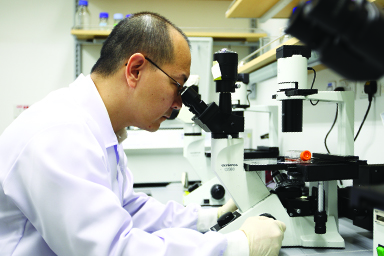NUHS Institutions will NEVER ask you to transfer money or disclose bank details over a call.
If in doubt, call the 24/7 ScamShield helpline at 1799, or visit the ScamShield website at www.scamshield.gov.sg.
Make an appointment or seek a second opinion here.
The prostate is a gland found exclusively in males. Located in front of the rectum and below the urinary bladder, the prostate is about the size of a walnut. The prostate reaches nearly full size during puberty but may continue to grow slightly more in older men and it produces some of the fluid that protects and nourishes sperm cells in semen. Glands called seminal vesicles that make most of this fluid are found behind the prostate. Prostate cancer usually occurs in the epithelial cells of the glandular tissue. This type of cancer is known as adenocarcinoma.
*People who think they may be at risk should discuss this with their doctor.
*A doctor should be consulted should these symptoms occur.
The growth rate of prostate cancer varies among men. In some men, prostate cancer develops slowly and does not cause any problem. Yet, it grows faster in some others and can result in severe pain or other problems, even death. Screening tests can help to detect prostate cancer early.
Digital Rectal Examination
This is the first step in diagnosing prostate cancer. The doctor uses a gloved finger to examine the rectum.
Prostate-specific Antigen (PSA)
PSA is a substance produced by both normal and malignant prostate cells. The presence of elevated levels of PSA in the blood is another test that helps to detect prostate cancer.
Transrectal Ultrasound Guidance (TRUS)
TRUS is the use of soundwaves to create an image of the prostate. It is used to guide a biopsy of the prostate.
Biopsy
This procedure removes some sample tissue for analysis. If the biopsy is positive for cancer, imaging such as bone scan, Magnetic Resonance Imaging (MRI) and/or Computed Tomography (CT) scanning of the pelvis may be needed to help determine the extent of the cancer.
Surgery
A procedure called radical prostectomy may be recommended if the tumour is localised at the prostate. It involves the complete removal of the prostate and often includes the pelvic lymph nodes. This procedure is commonly used to treat early stages of prostate cancer. Some possible side effects of radical prostectomy include incontinence (not being able to control urine) and impotence (not being able to have erections). These side effects can also happen with other forms of treatment for prostate cancer.
Radiation Therapy
Radiation therapy uses high-energy beams to kill the cancer cells. External beam radiotherapy (EBRT) focuses radiation from outside the body on the cancer. EBRT techniques involved may include Three-dimensional Conformal Radiation Therapy (3D-CRT) where radiation beams are shaped and aimed at the tumour from several directions. Stereotactic Body Radiation Therapy (SBRT) uses highly focused beams of high-dose radiation given on one day or over several days. Brachytherapy is another form of radiotherapy that involves the surgical placement of permanent or temporary implants to deliver radiation to the prostate.
Hormone Therapy
Hormonal therapy is commonly used to treat prostate cancer when it has spread or in combination with radiotherapy when the cancer is locally advanced or high risk. Hormonal therapy can slow the cancer growth as it interferes with the growth stimulatory effects of male hormones on prostate cancer. There are two forms of hormonal therapy:
Chemotherapy
Though uncommon, chemotherapy plays a role in improving symptoms of prostate cancer if hormone therapy is ineffective. It is generally well-tolerated and can alleviate bone pain for most patients. Chemotherapy is usually given in cycles with each cycle lasting for a few weeks. The body is given time to recover during a rest period that follows each cycle of treatment.
Active Surveillance or Watchful Waiting
As some prostate cancers grow very slowly and may take many years to cause symptoms or spread, some men with diagnosed prostate cancer may not need immediate treatment. Active surveillance refers to a protocol that allows patients with localized prostate cancer to be observed safely for a period of time, and then for deferred treatment when necessary. Watchful waiting is also advocated as a reasonable approach for some men with prostate cancer (especially asymptomatic men with a limited life expectancy) who are observed and treated only when symptoms or spread occurs.
Energy Ablative Therapy
Energy ablative therapies such as cryotherapy have been offered as minimally invasive therapy options for highly selected men with localized prostate cancer. Cryotherapy involves placing cryoneedles into the prostate through the perineal skin, and uses controlled freezing and thawing to destroy prostate cancer cells. This form of treatment is sometimes used in men whose prostate cancer has returned following other treatments.

Prostate Cancer Care Approach

Prostate Cancer Care Team

Prostate Cancer Online Resource Library

Patient Support Groups

Prostate Cancer Clinical Trials

Prostate Cancer Resesarch